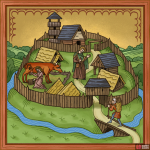Text
Gords or hillforts, sometimes called Burgwalls, were fortified settlements of various sizes, established from the Neolithic period right through to the early Middle Ages. They were built using natural terrain or the protection of waterways, on islands or hills. Within the outer walls there would typically be a central fort.
These strongholds were mostly built from timber, with an outer palisade (stockade) and ditch or moat. The stronghold fulfilled a protective and strategic function in times of war and also served as a stopover on trade routes or as goods transfer stations.
Semine hillfort
Not far from the Semine fortress is the largest documented Celtic gord in the Czech lands. The hardly accessible site, in the middle of forests and rocks, above the confluence of rivers, ideally fulfilled the conditions for a strategic settlement. The Celts probably built an oppidium here - an early Medieval form of fortified settlement - or a refugium - a temporary refuge during wars.
According to research, the fortress had three ramparts and moats in addition to natural fortifications. Inside, pottery from the La Tène period and remains of masonry made of black basalt, which was also used at Trosky Castle, were found. This suggests that the hillfort may have even been surrounded by a stone wall.
According to some hypotheses, the Celts also had a sacred place here, as during the solar equinox, the sunset can be seen from the top of Semine hill between the rocks on which Trosky Castle stands.
Since 2018, a reconstruction of the hillfort has been standing on the site, where it is possible to learn about the history of Bohemian Paradise.


No Comments